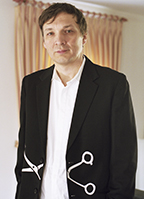EECS Department Colloquium Series
Computational Reality
 |
Wednesday, February 5, 2014 Ivan Poupyrev |
ABSTRACT:
The digital revolution is over. The bits won and have invaded every aspect of our life, changing the essence of how we live, work, and play. Information is no longer confined to the pixels on our screens. Instead the entire physical world, even living and breathing matter, are being infused with data demanding new, unprecedented forms of interactivity.
In my projects I invent and design future interactive technologies that will seamlessly merge the digital and physical worlds. I focus on creating technologies that can enhance and augment everything around us with interactive and digital data: humans, animals, plants, as well as man-made artifacts, structures, and entire cities. My tools of choice are micro-manufacturing, material design, as well as sophisticated electrical engineering techniques among others. My design philosophy is to hack nature, i.e. using fundamental physical and physiological mechanisms already present in physical matter for the purpose of digital control and display.
In this talk I will discuss my motivation, research approach, and vision for the future, in the broader context of my work over the last 15 years exploring virtual and augmented reality, bendable and shape changing computers, early tactile feedback devices for touch screens, and others.
BIOGRAPHY:
Dr. Ivan Poupyrev is a Technical Program Lead and Associate VP at Advanced Technologies and Projects division of Google Motorola. Until one month ago he was a Principal Research Scientist at the Walt Disney Company, where he directed an Interactive Technologies Group in the Disney Research Pittsburgh laboratory tasked with dreaming up and developing future technologies for Disney parks, resorts, and cruises. Prior to Disney, Ivan worked as a researcher at Sony Computer Science Laboratories in Tokyo, Japan where he investigated and invented novel interfaces for future consumer electronic devices. He also did a stint at the Human Interface Technology Laboratory at the University of Washington as a visiting scientist while working on his Ph.D. dissertation at Hiroshima University, Japan.
Ivan's research focuses on inventing breakthrough new technologies and designing innovative interaction paradigms that seamlessly blend digital and physical interactivity in devices, everyday objects, and living environments on a very large scale. His research and innovations span a broad range of topics including virtual and augmented reality, haptics, sensing and actuators, interactive biological matter, energy harvesting, 3D printing and additive manufacturing and much more.
The results of his work have been presented at major international scientific conferences, such as ACM SIGGRAPH, CHI, UIST and ISMAR to name a few, where it received multiple Best Paper and Best Demo awards and nominations. He is actively involved in academic community and was serving as a Program Chair for ACM UIST 2013 conference. His research was broadly reported in popular media including BBC, CNN, Wired, New York Times, New Scientist, Financial Times, The Washington Post, NIKKEI, Forbes, Time, MIT Technology review and many others. Besides international recognition, the results of his research were released on the market in a variety of products worldwide. His innovations in interaction design received the Nokia Ubimedia Award, were featured in the International Design Biennale in Saint-Etienne, were nominated for National Design Award by Smithsonian Cooper-Hewitt National Design Museum and received Honorable Mention at ARS Prix Electronica in 2013. Forrester Media featured him as one of the leading Digital Disruptors in 2013 and Bloomberg Business Week featured his profile as one of the Innovators of 2012. In 2013, Fast Company Magazine recognized him as one of the World's 100 Most Creative People calling him "one of the greatest interaction designers in the world."
| Return to EECS Joint Colloquium |


